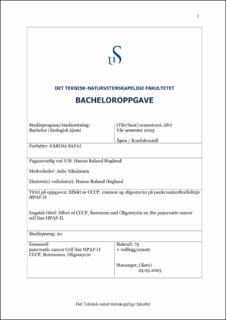| dc.description.abstract | This bachelor thesis focuses on pancreatic cancer cells, HPAF-II, and their response to treatment with mitochondrial inhibitors such us CCCP, Rotenone and oligomycin.
To assess the cell response after treatment with CCCP, Rotenone and Oligomycin vi used Alamar Blue metabolic assay. To determine the optimal cell seeding density, we first ran an experiment with increasing cell density concentrations and evaluated using Alamar Blue.
The HPAF-II cells were treated with different inhibitors for 24 hours and 48 hours before assessing viability. CCCP is an uncoupling agent that collapses the proton gradient and disrupts the mitochondrial membrane potential, which further cause mitochondrial swelling and cell death. The results showed that CCCP affect the cells as the cell viability decreased when the CCCP concentration increased, with 50 µM CCCP at 48 hours showed the highest cell death. Rotenone is an inhibitor that inhibits complex I of electron transport chain, and it causes blockade of electron transport chain, which further cause inhibiting ATP synthesis. The results showed that Rotenone had negative effect on the cell as the cell viability increased when the Rotenone concentration increased. Oligomycin is another inhibitor that inhibits the ATP synthase that cells cannot produce ATP. The results showed that Oligomycin affect the cell viability decreased when the Oligomycin concentration increased, with 500 nM Oligomycin at 48 hours showed the highest cell death.
The seahorse analyzer measuring the two energy pathways of the cells, mitochondrial respiration, and glycolysis. This was done by measuring the rates of oxygen consumption (OCR) and lactate secretion in the medium surrounding the cells. By measuring the oxygen consumption and free protons in the extracellular flux we can determine the bioenergetic status of the cells. The result shows that the HPAF-II cell line is energetic and using both mitochondrial respiration and glycolysis to produce ATP and this cell line forms a lot of lactates and consumes more oxygen. | |
